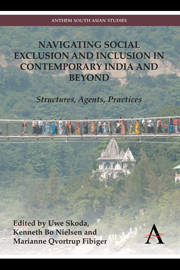 Navigating Social Exclusion and Inclusion in Contemporary India and Beyond
Navigating Social Exclusion and Inclusion in Contemporary India and Beyond from Part II - Communities and Politics
Published online by Cambridge University Press: 05 September 2013
Through the mechanisms of competitive electoral politics, caste is being continuously reinvented in contemporary India. The ‘deepening’ of democracy has come with a fragmentation of politics, producing new political bodies representing newly politicized groups that express new demands in a new language (Yadav 1999). This development has shattered modernist expectations that democracy, industrialization and economic liberalization would lead to a shift from ‘traditional’ primordial identities to people seeing themselves as citizens whose rights and duties should be negotiated individually, primarily through the ballot. Rather, formulations of rights claims in India have happened increasingly along caste and community lines.
In this chapter, this process of politicization is seen through the idea of ‘Dalit-hood’. The activists who figure here are part of an emerging politics of difference, seeking to redefine collectively the status of the group to which they belong. This politics of difference is based on the assumption that ‘social exclusion’ makes Dalits a unified group. The material I present here is based on six months of fieldwork among Dalit activists in North India in 2009. During this time I spent three months as an intern with the Dalit Cooperation Committee (DCC), a Delhi-based umbrella organization engaging in advocacy, legal aid, mobilizational activities and awareness raising. Divided into four branches focusing on different problem areas, my internship was with the Women's Wing of the DCC. In this urban, middle-class context, the chapter analyses activists' claims to Dalit-hood.
To save this book to your Kindle, first ensure [email protected] is added to your Approved Personal Document E-mail List under your Personal Document Settings on the Manage Your Content and Devices page of your Amazon account. Then enter the ‘name’ part of your Kindle email address below. Find out more about saving to your Kindle.
Note you can select to save to either the @free.kindle.com or @kindle.com variations. ‘@free.kindle.com’ emails are free but can only be saved to your device when it is connected to wi-fi. ‘@kindle.com’ emails can be delivered even when you are not connected to wi-fi, but note that service fees apply.
Find out more about the Kindle Personal Document Service.
To save content items to your account, please confirm that you agree to abide by our usage policies. If this is the first time you use this feature, you will be asked to authorise Cambridge Core to connect with your account. Find out more about saving content to Dropbox.
To save content items to your account, please confirm that you agree to abide by our usage policies. If this is the first time you use this feature, you will be asked to authorise Cambridge Core to connect with your account. Find out more about saving content to Google Drive.